Stabilization of Chromium Waste by Solidification into Cement Composites
Abstract
:1. Introduction
2. Materials and Methods
2.1. Materials and Preparation of Mortar Mixes
2.2. Testing Methodology
2.2.1. Toxicity Characteristic Leaching Procedure (TCLP) Test
2.2.2. Modeling and Simulation of Cr Leachate Release from Monoliths
3. Results and Discussion
3.1. Mechanical Tests
3.2. TCLP Leaching Test
Chemical Properties
- (i).
- The dissolution of portlandite occurs when the pH is below 12.5 [44].
- (ii).
- The decomposition of C-S-H and ettringite takes place, resulting in a silica gel residue, when pH values are below 10.6 and 8.8, respectively [44].
- (iii).
- Strongly soluble phases such as KOH and NaOH dissolve, neutralizing the leachant’s acidity and aligning the pH with that of the strongly basic interstitial solution within the cement mortar. Consequently, chromium release becomes significantly diminished [44].
3.3. X-ray Diffraction (XRD) Analysis of S/S Mortars
3.4. Infrared Analysis (IR) of S/S Mortars
3.5. Modelling and Simulation
- -
- A residual variance of the order of zero;
- -
- A closeness to one for the coefficients of determination;
- -
- The models being integer-validated because the calculated values of the Fisher tests are more significant than the tabulated values of the Fisher tests;
- -
- Student’s t-test values demonstrating that all model coefficients are preserved apart from the constant K3, which is rejected by the delay in leaching;
- -
- The release of chromium being controlled by surface phenomena, as indicated by the simplex method and corroborated by statistical tests.
3.6. Degradation of Monolithic Cubes during the TCLP Test
4. Conclusions
Author Contributions
Funding
Institutional Review Board Statement
Informed Consent Statement
Data Availability Statement
Conflicts of Interest
References
- Estokova, A.; Palascakova, L.; Kanuchova, M. Study on Cr(VI) Leaching from Cement and Cement Composites. Int. J. Environ. Res. Public Health 2018, 15, 824. [Google Scholar] [CrossRef] [PubMed]
- Tchounwou, P.B.; Yedjou, C.G.; Patlolla, A.K.; Sutton, D.J. Heavy metal toxicity and the environment. Mol. Clin. Environ. Toxicol. 2012, 101, 133–164. [Google Scholar] [CrossRef]
- Varitis, S.; Kavouras, P.; Pavlidou, E.; Pantazopoulou, E.; Vourlias, G.; Chrissafis, K.; Zouboulis, A.; Karakostas, T.; Komninou, P. Vitrification of incinerated tannery sludge in silicate matrices for chromium stabilization. Waste Manag. 2017, 59, 237–246. [Google Scholar] [CrossRef]
- Chakraborty, V.; Sengupta, S.; Chaudhuri, P.; Das, P. Assessment on removal efficiency of chromium by the isolated manglicolous fungi from Indian Sundarban mangrove forest: Removal and optimization using response surface methodology. Environ. Technol. Innov. 2018, 10, 335–344. [Google Scholar] [CrossRef]
- Sharma, P.; Singh, S.P.; Parakh, S.K.; Tong, Y.W. Health hazards of hexavalent chromium (Cr (VI)) and its microbial reduction. Bioengineered 2022, 13, 4923–4938. [Google Scholar] [CrossRef] [PubMed]
- Liang, J.; Huang, X.; Yan, J.; Li, Y.; Zhao, Z.; Liu, Y.; Wei, Y. A review of the formation of Cr(VI) via Cr(III) oxidation in soils and groundwater. Sci. Total Environ. 2021, 774, 145762. [Google Scholar] [CrossRef]
- Achmad, R.T.; Budiawan; Auerkari, E.I. Effects of Chromium on Human Body. Annu. Res. Rev. Biol. 2017, 13, 1–8. [Google Scholar] [CrossRef]
- Li, S.; Zhang, Y.; Feng, R.; Yu, H.; Pan, J.; Bian, J. Environmental Safety Analysis of Red Mud-Based Cemented Backfill on Groundwater. Int. J. Environ. Res. Public Health 2021, 18, 8094. [Google Scholar] [CrossRef]
- Ashraf, A.; Bibi, I.; Niazi, N.K.; Ok, Y.S.; Murtaza, G.; Shahid, M.; Kunhikrishnan, A.; Li, D.; Mahmood, T. Chromium(VI) sorption efficiency of acid-activated banana peel over organo-montmorillonite in aqueous solutions. Int. J. Phytoremed. 2017, 19, 605–613. [Google Scholar] [CrossRef]
- Kazakis, N.; Kantiranis, N.; Kalaitzidou, K.; Kaprara, E.; Mitrakas, M.; Frei, R.; Vargemezis, G.; Tsourlos, P.; Zouboulis, A.; Filippidis, A. Origin of hexavalent chromium in groundwater: The example of Sarigkiol Basin, Northern Greece. Sci. Total Environ. 2017, 593–594, 552–566. [Google Scholar] [CrossRef]
- Jones, A.S.; Marini, J.; Solo-Gabriele, H.M.; Robey, N.M.; Townsend, T.G. Arsenic, copper, and chromium from treated wood products in the U.S. disposal sector. Waste Manag. 2019, 87, 731–740. [Google Scholar] [CrossRef] [PubMed]
- Pellerin, C.; Booker, S.M. Reflections on hexavalent chromium: Health hazards of an industrial heavyweight. Environ. Health Perspect. 2000, 108, A402–A407. [Google Scholar] [CrossRef] [PubMed]
- Yang, Y.; Ma, H.; Chen, X.; Zhu, C.; Li, X. Effect of incineration temperature on chromium speciation in real chromium-rich tannery sludge under air atmosphere. Environ. Res. 2020, 183, 109159. [Google Scholar] [CrossRef] [PubMed]
- Vaiopoulou, E.; Gikas, P. Regulations for chromium emissions to the aquatic environment in Europe and elsewhere. Chemosphere 2020, 254, 126876. [Google Scholar] [CrossRef]
- Munn, S.J.; Allanou, R.; Aschberger, K.; Berthault, F.; Cosgrove, O.; Luotamo, M.; Pakalin, S.; Paya-Perez, A.; Pellegrini, G.; Schwarz-Schulz, B.; et al. Chromium Trioxide, Sodium Chromate, Sodium Dichromate, Ammonium Dichromate, Potassium Dichromate, EUR 21508 EN; European Union Risk Assessment Report; Office for Official Publications of the European Communities: Luxembourg, 2005; Volume 53. [Google Scholar]
- Food and Agriculture Organization of the United Nations. World Statistical Compendium for Raw Hides and Skins, Leather and Leather Footwear 1999–2015; Food and Agriculture Organization of The United Nations: Rome, Italy, 2016; Available online: http://www.fao.org/3/a-i5599e.pdf (accessed on 15 January 2020).
- Joseph, A.M.; Snellings, R.; Van den Heede, P.; Matthys, S.; De Belie, N. The Use of Municipal Solid Waste Incineration Ash in Various Building Materials: A Belgian Point of View. Materials 2018, 11, 141. [Google Scholar] [CrossRef]
- European ICCP Bureau. Reference Document on Best Available Techniques for the Tanning of Hides and Skins; European ICCP Bureau: Seville, Spain, 2013; Available online: http://eippcb.jrc.ec.europa.eu/reference/BREF/TAN_Published_def.pdf (accessed on 15 January 2020).
- Ballesteros, S.; Rincón, J.; Rincón-Mora, B.; Jordán, M. Vitrification of urban soil contamination by hexavalent chromium. J. Geochem. Explor. 2017, 174, 132–139. [Google Scholar] [CrossRef]
- Rincón-Mora, B.; Jordan, M.; Rincón, J.M. Chromium oxide additions in lithium disilicate glass crystallization. Mater. Lett. 2016, 179, 138–141. [Google Scholar] [CrossRef]
- Zha, F.S.; Xu, L.; Cui, K.R. Study on strength characteristics of heavy metal contaminated soils solidified/stabilized by cement. Rock Soil Mech. 2012, 33, 652–656. [Google Scholar]
- Zhou, Y.; Cai, G.; Cheeseman, C.; Li, J.; Poon, C.S. Sewage sludge ash-incorporated stabilisation/solidification for recycling and remediation of marine sediments. J. Environ. Manag. 2022, 301, 113877. [Google Scholar] [CrossRef]
- Xiong, X.; Zhang, Y.; Wang, L.; Tsang, D.C.W. Chapter 1—Overview of Hazardous Waste Treatment and Stabilization/Solidification Technology, Low Carbon Stabilization and Solidification of Hazardous Wastes; Elsevier: Amsterdam, The Netherlands, 2022; pp. 1–14. [Google Scholar]
- Shabalala, A.N.; Basitere, M. Interactive Relationship between Cementitious Materials and Acid Mine Drainage: Their Effects on Chromium Cr(VI) Removal. Minerals 2020, 10, 932. [Google Scholar] [CrossRef]
- Sanito, R.C.; Bernuy-Zumaeta, M.; You, S.-J.; Wang, Y.-F. A review on vitrification technologies of hazardous waste. J. Environ. Manag. 2022, 316, 115243. [Google Scholar] [CrossRef] [PubMed]
- Long, L.; Zhao, Y.; Lv, G.; Duan, Y.; Liu, X.; Jiang, X. Improving stabilization/solidification of MSWI fly ash with coal gangue based geopolymer via increasing active calcium content. Sci. Total Environ. 2023, 854, 158594. [Google Scholar] [CrossRef]
- Belebchouche, C.; Moussaceb, K.; Aït-Mokhtar, A. Evaluation of the encapsulation of nickel, chromium and lead-rich wastes in cement matrices by TCLP test. Eur. J. Environ. Civ. Eng. 2015, 20, 711–724. [Google Scholar] [CrossRef]
- Belebchouche, C.; Moussaceb, K.; Hammoudi, A. Influence of the Release Kinetics of Chemical Species on the Sus-tainability of Stabilized/Solidified Materials with Hydraulic Binder Subjected to Chemically Aggressive Environments. Arab. J. Sci. Eng. 2019, 44, 9997–10015. [Google Scholar] [CrossRef]
- Kim, H.T.; Lee, T.G. A simultaneous stabilization and solidification of the top five most toxic heavy metals (Hg, Pb, As, Cr, and Cd). Chemosphere 2017, 178, 479. [Google Scholar] [CrossRef] [PubMed]
- Li, Y.; Min, X.; Ke, Y.; Fei, J.; Liu, D.; Tang, C. Immobilization potential and immobilization mechanism of arsenic in cemented paste backfill. Miner. Eng. 2019, 138, 101–107. [Google Scholar] [CrossRef]
- Liu, M.; Zhao, Y.; Yu, Z.; Cao, Z. Impact of Ni(II) and Cd(II) on the hydration and microstructure of cement pastes for immo-bilization: C-A-S-H composition and binding characteristic. Constr. Build. Mater. 2021, 310, 125284. [Google Scholar] [CrossRef]
- Mao, Y.; Muhammad, F.; Yu, L.; Xia, M.; Huang, X.; Jiao, B.; Shiau, Y.; Li, D. The Solidification of Lead-Zinc Smelting Slag through Bentonite Supported Alkali-Activated Slag Cementitious Material. Int. J. Environ. Res. Public Health 2019, 16, 1121. [Google Scholar] [CrossRef]
- Deng, W.; Fu, P.; Fang, G.; Zhu, W.; Li, S.; Wang, X.; Xue, T.; Chen, Y. Solidification/Stabilization of MSWI Fly Ash Using a Novel Metallurgical Slag-Based Cementitious Material. Minerals 2022, 12, 599. [Google Scholar] [CrossRef]
- Gmira, A. Etude Structurale et Thermodynamique D’hydrates Modèle du Ciment. Ph.D. Thesis, Université d’Orléans, Orléans, France, 2003. [Google Scholar]
- Belebchouche, C.; Moussaceb, K.; Hammoudi, A.; Amouri, C. Modeling and evaluation of the performance of the stabiliza-tion/solidification process of hazardous compound PbO by toxicity characteristic leaching procedure test. Rev. Romana Mater. 2018, 48, 260–267. [Google Scholar]
- Van Gerven, T.; Cornelis, G.; Vandoren, E.; Vandecasteele, C. Effects of carbonation and leaching on porosity in cement-bound waste. Waste Manag. 2007, 27, 977–985. [Google Scholar] [CrossRef] [PubMed]
- Imyim, A. Méthodologie D’évaluation Environnementale Des Déchets Stabilisés/Solidifiés par Liants Hydrauliques. Ph.D. Thesis, Institut National des Sciences Appliquées de Lyon, Lyon, France, 2000. [Google Scholar]
- Environmental Protection Agency. METHOD 1311:1992 Test methods for evaluating solid wastes. In Physical/Chemical Methods: Toxicity Characteristic Leaching Procedure; Environmental Protection Agency: Washington, DC, USA, 1992. [Google Scholar]
- Richardson, G.L. The phantom dissolution leach model. Nucl. Chem. Waste Manag. 1981, 2, 237–241. [Google Scholar] [CrossRef]
- Cote, P.L. Contaminant Leaching from Cement-Based Waste Forms under Acidic Conditions. Ph.D. Thesis, McMaster University at Hamilton, Hamilton, ON, Canada, 1986. [Google Scholar]
- Gilliam, T.M.; Wiles, C.C. Stabilization and Solidification of Hazardous, Radioactive, and Mixed Wastes; American Society for Testing and Materials: Conshohocken, PA, USA, 1992. [Google Scholar]
- NF X31-211:2012; Caractérisation des Déchets. Essai de Lixiviation D’un Déchet Solide Initialement Massif ou Généré par un Procédé de Solidification. AFNOR: La Plaine Saint-Denis, France, 2012.
- Shakir, S.; de Hemptinne, J.-C. The effect of diffusion on the modeling of the water-washing phenomenon. J. Pet. Sci. Eng. 2007, 58, 403–412. [Google Scholar] [CrossRef]
- Alexander, M.; Bertron, A.; De-Belie, N. Performance of Cement-Based Materials in Aggressive Aqueous Environments: State-of-the-Art Report; RILEM TC 211—PAE; Springer: Dordrecht, The Netherlands, 2013. [Google Scholar]
- Deschamps, T.; Benzaazoua, M.; Bussière, B.; Belem, T.; Mbonimpa, M. Mécanismes de Rétention des Métaux Lourds en Phase Solide: Cas de la Stabilisation Des Sols Contaminés et Des Déchets Industriels; Vertigo 7: Article numéro 2; Vertigo: Rome, Italy, 2006. [Google Scholar]
- Liu, J.; Wu, D.; Tan, X.; Yu, P.; Xu, L. Review of the Interactions between Conventional Cementitious Materials and Heavy Metal Ions in Stabilization/Solidification Processing. Materials 2023, 16, 3444. [Google Scholar] [CrossRef]
- Dana, G. Constantes des Specters Infrarouges. Les Techniques de L’ingénieur K 1010; Techniques de l’ingenieur: Saint-denis, France, 1999. [Google Scholar]
- Fantozzi-Merle, C. Etude de Matériaux à Base de Liant Hydraulique Contenant des Pollutants Organiques Modèles: Pro-Priétésstructurales et de Transfert. Ph.D. Thesis, Institut National des Sciences Appliquées de Lyon, Lyon, France, 2003. [Google Scholar]
- Planel, D. Les Effets Couplés de la Precipitation D’espèces Secondaires sur le Comportement Mécanique et la Dégradation des Bétons. Ph.D. Thesis, Université Paris-East Marne-la-Vallée, Paris, France, 2002. [Google Scholar]
- Sheheryar, M.; Rehan, R.; Nehdi, M.L. Estimating CO2 Emission Savings from Ultrahigh Performance Concrete: A System Dynamics Approach. Materials 2021, 14, 995. [Google Scholar] [CrossRef]




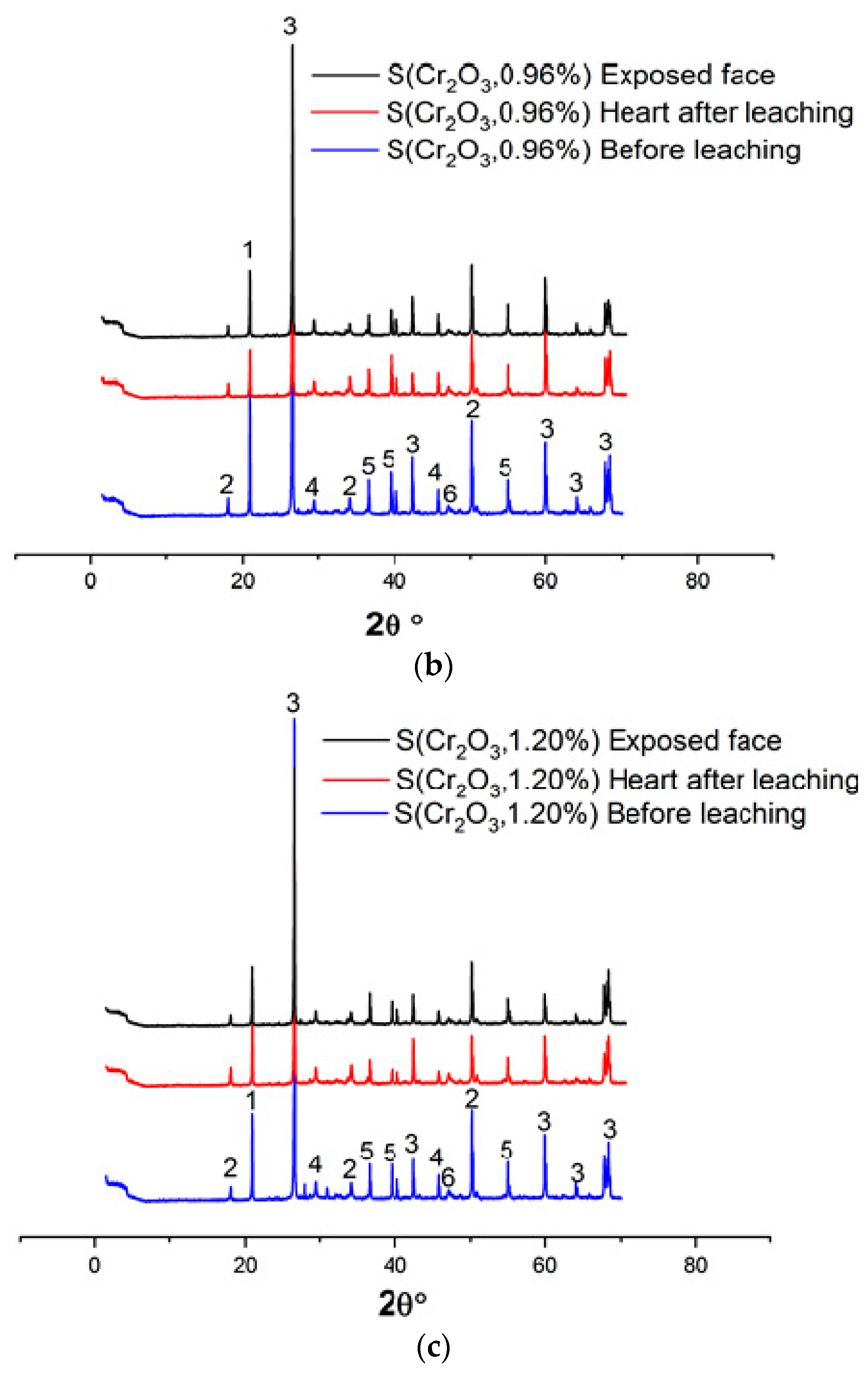
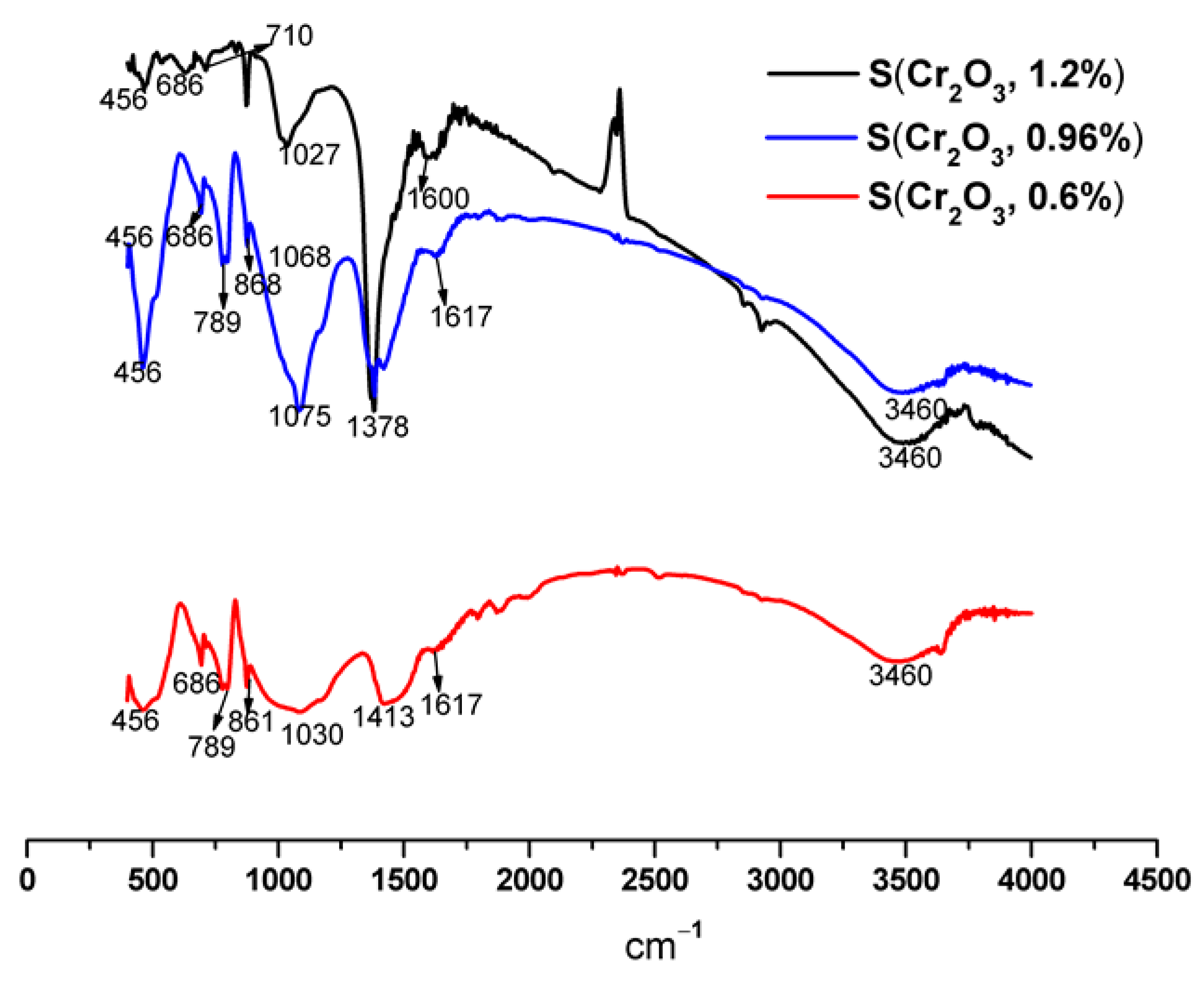
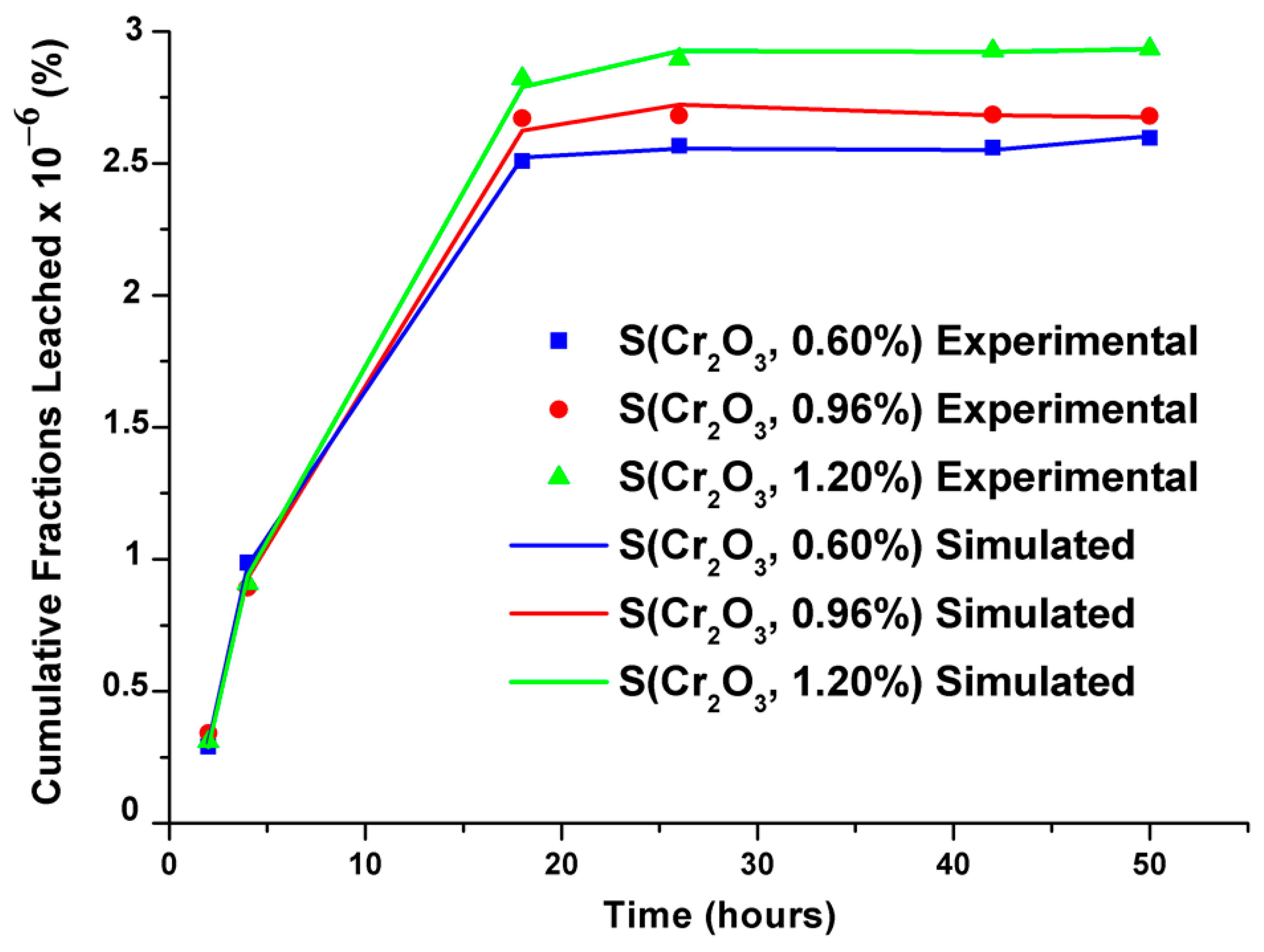
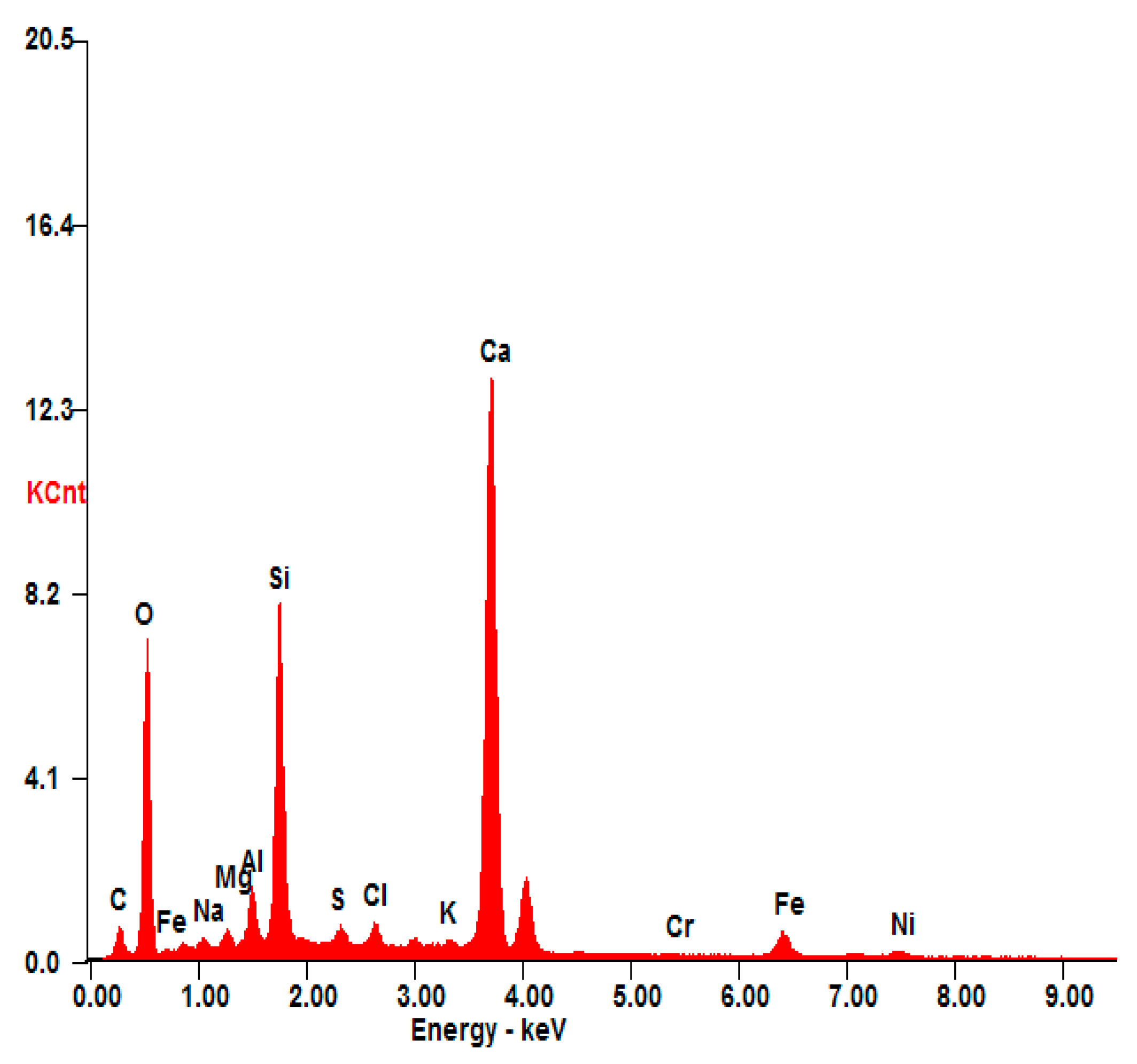
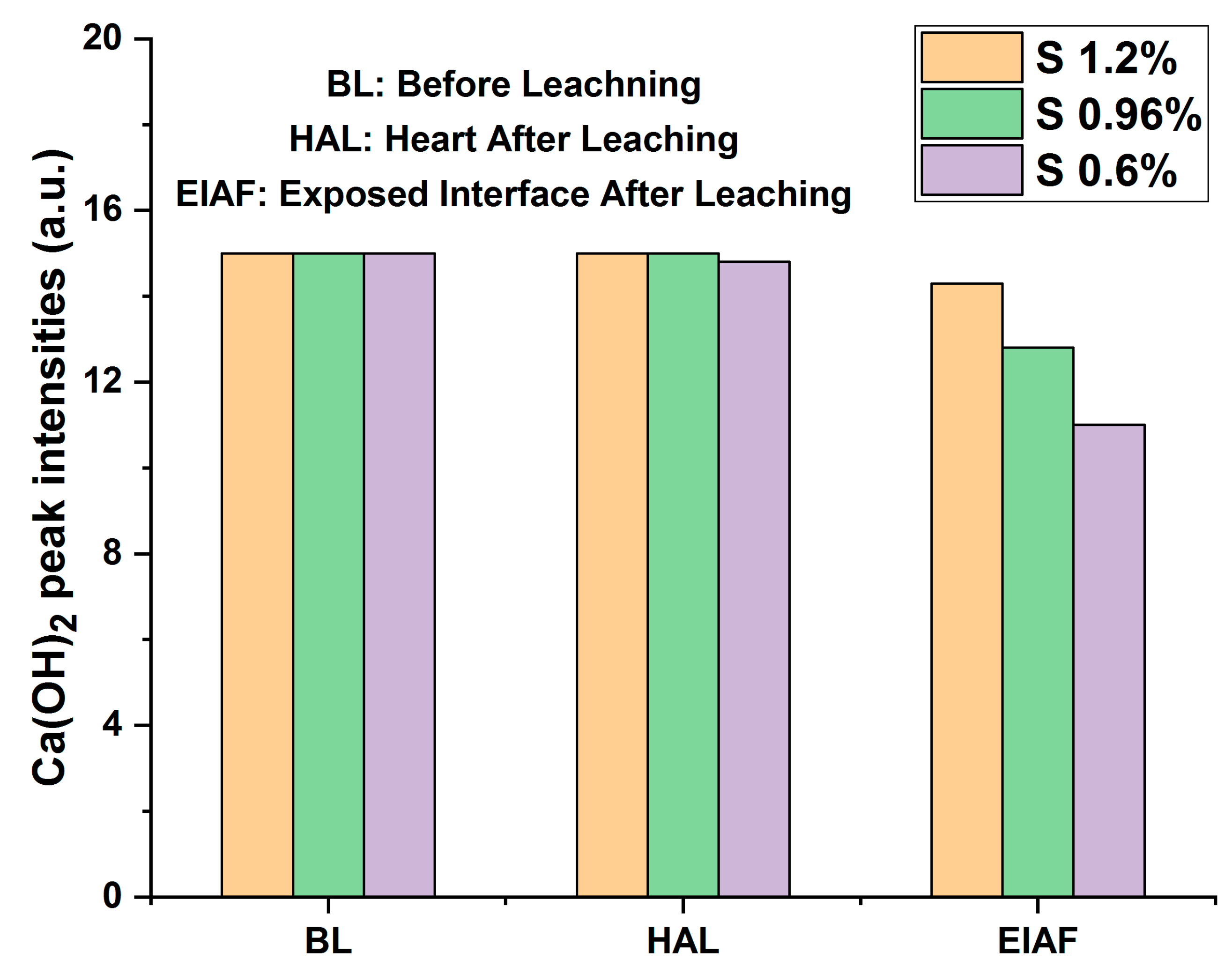
| Compound | SiO2 | Al2O3 | Fe2O3 | CaO | MgO | SO3 | K2O + Na2O | Cr2O3 |
|---|---|---|---|---|---|---|---|---|
| Cement (%) | 28.36 ± 0.04 | 6.82 ± 0.09 | 3.48 ± 0.07 | 58.57 ± 0.22 | 1.03 ± 0.02 | 1.52 ± 0.02 | 0.17 ± 0.01 | n.d. |
| Pure waste (%) | n.d. 1 | n.d. | n.d. | n.d. | n.d. | n.d. | n.d. | 99.94 ± 0.03 |
| Standard sand (%) | 98.05 ± 0.23 | 0.54 ± 0.05 | 0.07 ± 0.01 | n.d. | n.d. | n.d. | n.d. | n.d. |
| Designation | Rc (MPa) | Rf (MPa) |
|---|---|---|
| S (Control, 0%) | 34.62 ± 1.22 | 6.34 ± 0.43 |
| S(Cr2O3, 0.6%) | 36.36 ± 0.87 | 6.47 ± 0.31 |
| S(Cr2O3, 0.96%) | 39.22 ± 1.65 | 6.69 ± 0.09 |
| S(Cr2O3, 1.2%) | 42.32 ± 0.54 | 7.20 ± 0.17 |
| Levy | pH | Conductivity (ms) | Cumulative Time (Hours) | [Cr] (μmol/L) in the Leachate | [Cr]0(μmol/L) Initial | C.L.F. |
|---|---|---|---|---|---|---|
| 1 | 5.08 | 4.10 | 2 | 0.07499 | 258,500 | 2.901 × 10−7 |
| 2 | 5.18 | 4.10 | 4 | 0.25509 | 9.868 × 10−7 | |
| 3 | 5.38 | 4.60 | 18 | 0.64860 | 2.509 × 10−6 | |
| 4 | 5.46 | 4.60 | 26 | 0.66346 | 2.566 × 10−6 | |
| 5 | 5.65 | 5.48 | 42 | 0.67115 | 2.559 × 10−6 | |
| 6 | 5.80 | 5.00 | 50 | 0.67115 | 2.596 × 10−6 |
| Levy | pH | Conductivity (ms) | Cumulative Time (Hours) | [Cr] (μmol/L) in the Leachate | [Cr]0(μmol/L) Initial | C.L.F. |
|---|---|---|---|---|---|---|
| 1 | 5.15 | 4.30 | 2 | 0.13990 | 411,000 | 3.404 × 10−7 |
| 2 | 5.20 | 4.30 | 4 | 0.36661 | 8.820 × 10−7 | |
| 3 | 5.44 | 5.21 | 18 | 1.09753 | 2.670 × 10−6 | |
| 4 | 5.53 | 4.90 | 26 | 1.10189 | 2.681 × 10−6 | |
| 5 | 5.68 | 6.18 | 42 | 1.10382 | 2.685 × 10−6 | |
| 6 | 6.48 | 5.70 | 50 | 1.10164 | 2.680 × 10−6 |
| Levy | pH | Conductivity (ms) | Cumulative Time (Hours) | [Cr] (μmol/L) in the Leachate | [Cr]0(μmol/L) Initial | C.L.F. |
|---|---|---|---|---|---|---|
| 1 | 5.19 | 4.20 | 2 | 0.15384 | 498,000 | 3.089 × 10−7 |
| 2 | 5.17 | 4.10 | 4 | 0.45250 | 9.086 × 10−7 | |
| 3 | 5.43 | 4.70 | 18 | 1.40595 | 2.823 × 10−6 | |
| 4 | 5.58 | 4.92 | 26 | 1.44230 | 2.896 × 10−6 | |
| 5 | 5.73 | 5.10 | 42 | 1.45769 | 2.927 × 10−6 | |
| 6 | 5.79 | 5.29 | 50 | 1.46154 | 2.934 × 10−6 |
| Legend | Compound Name | Chemical Formula | Reference Pattern |
|---|---|---|---|
| 1 | Calcium Chromium Oxide Hydrate | CaCrO4·2H2O | 00-038-1186 |
| 2 | Portlandite | Ca(OH)2 | 00-004-0733 |
| 3 | Quartz | SiO2 | 00-046-1045 |
| 4 | Calcium Chromium Sulfate Hydroxide Hydrate | Ca6Cr2(SO4)3(OH)12·26H2O | 00-033-0248 |
| 5 | Ettringite | Ca6Al2(SO4)3(OH)12·26H2O | 00-041-1451 |
| 6 | Calcite | CaCO3 | 00-005-0586 |
| Wave Number cm−1 | |||
|---|---|---|---|
| S(Cr2O3, 0.6%) | S(Cr2O3, 0.96%) | S(Cr2O3, 1.2%) | |
| OH of portlandite | 3460 | 3460 | 3460 |
| H2O adsorbed | 1617 | 1617 | 1600 |
| C-S-H | 1378 | 1378 | 1378 |
| M-O | 1068 | 1075 | 1068 |
| C-S-H | 861 | 861 | 781 |
| Si-O | 686 | 686 | 622 |
| Surface Phenomenon | Diffusion | Chemical Reactions (Dissolution or Precipitation) | Correlation Coefficient | ||
|---|---|---|---|---|---|
| Mechanisms Controlling the Release of Cr for S(Cr2O3, 0.6%) | |||||
| Coefficients | K1 | K2 | K3 | K4 | R2 |
| 5.432 × 10−6 | 0.15622 | −9.227 × 10−7 | 7.3955 × 10−8 | 0.999 | |
| Student’s t-test T (n-m, α/2 = 4.514) | 51.98 | - | 29.69 | 31.16 | |
| Fisher test (Ftabulated = 9.78) | 11,879 | ||||
| Residual variance | 2.167 × 10−16 | ||||
| Mechanisms controlling the release of Cr for S(Cr2O3, 0.96%) | |||||
| Coefficients | K1 | K2 | K3 | K4 | R2 |
| 5.256 × 10−6 | 0.13359 | −7.251 × 10−7 | 5.1065 × 10−8 | 0.999 | |
| Student’s t-test T (n-m, α/2 = 4.514) | 18.32 | - | 9.16 | 8.85 | |
| Fisher test (Ftabulated = 9.78) | 1373 | ||||
| Residual variance | 2.126 × 10-15 | ||||
| Mechanisms controlling the release of Cr for S(Cr2O3, 1.20%) | |||||
| Coefficients | K1 | K2 | K3 | K4 | R2 |
| 5.679 × 10−6 | 0.12961 | −7.957 × 10−7 | 5.7839 × 10−8 | 0.999 | |
| Student’s t-test T (n-m, α/2 = 4.514) | 28.01 | - | 14.47 | 14.5 | |
| Fisher test (Ftabulated = 9.78) | 3254 | ||||
| Residual variance | 1.101 × 10−15 | ||||
| Designation | Initial Concentration of Cr (C0) en μmol/L | Cumulative Concentration Leached (Ci) en μmol/L | |
|---|---|---|---|
| S(Cr2O3, 0.6%) | 258,500 | 0.67 | 2.59 × 10−4 |
| S(Cr2O3, 0.96%) | 411,000 | 1.10 | 2.60 × 10−4 |
| S(Cr2O3, 1.2%) | 498,000 | 1.46 | 2.93 × 10−4 |
Disclaimer/Publisher’s Note: The statements, opinions and data contained in all publications are solely those of the individual author(s) and contributor(s) and not of MDPI and/or the editor(s). MDPI and/or the editor(s) disclaim responsibility for any injury to people or property resulting from any ideas, methods, instructions or products referred to in the content. |
© 2023 by the authors. Licensee MDPI, Basel, Switzerland. This article is an open access article distributed under the terms and conditions of the Creative Commons Attribution (CC BY) license (https://creativecommons.org/licenses/by/4.0/).
Share and Cite
Belebchouche, C.; Bensebti, S.-E.; Ould-Said, C.; Moussaceb, K.; Czarnecki, S.; Sadowski, L. Stabilization of Chromium Waste by Solidification into Cement Composites. Materials 2023, 16, 6295. https://doi.org/10.3390/ma16186295
Belebchouche C, Bensebti S-E, Ould-Said C, Moussaceb K, Czarnecki S, Sadowski L. Stabilization of Chromium Waste by Solidification into Cement Composites. Materials. 2023; 16(18):6295. https://doi.org/10.3390/ma16186295
Chicago/Turabian StyleBelebchouche, Cherif, Salah-Eddine Bensebti, Chaima Ould-Said, Karim Moussaceb, Slawomir Czarnecki, and Lukasz Sadowski. 2023. "Stabilization of Chromium Waste by Solidification into Cement Composites" Materials 16, no. 18: 6295. https://doi.org/10.3390/ma16186295
APA StyleBelebchouche, C., Bensebti, S.-E., Ould-Said, C., Moussaceb, K., Czarnecki, S., & Sadowski, L. (2023). Stabilization of Chromium Waste by Solidification into Cement Composites. Materials, 16(18), 6295. https://doi.org/10.3390/ma16186295








